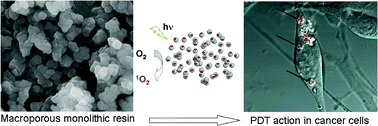Singlet oxygen generation using a porous monolithic polymer supported photosensitizer: potential application to the photodynamic destruction of melanoma cells†
Abstract
Photogeneration of singlet oxygen (1O2) by rose bengal is improved through the use of a porous monolithic


 Please wait while we load your content...
Please wait while we load your content...